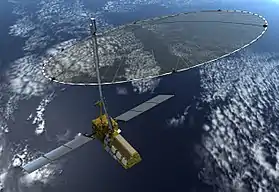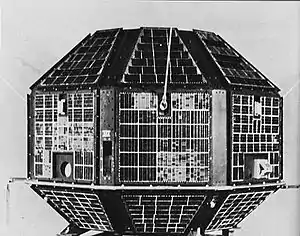NISAR (satellite)
The NASA-ISRO Synthetic Aperture Radar (NISAR) mission is a joint project between NASA and ISRO to co-develop and launch a dual-frequency synthetic aperture radar on an Earth observation satellite. The satellite will be the first radar imaging satellite to use dual frequencies. It will be used for remote sensing, to observe and understand natural processes on Earth. For example, its left-facing instruments will study the Antarctic cryosphere.[10] With a total cost estimated at US$1.5 billion, NISAR is likely to be the world's most expensive Earth-imaging satellite.[11]
 Artist's concept of the NASA-ISRO Synthetic Aperture Radar (NISAR) satellite in orbit. | |
| Names | NASA-ISRO Synthetic Aperture Radar NISAR |
|---|---|
| Mission type | Radar imaging |
| Operator | NASA / ISRO |
| Website | nisar www |
| Mission duration | 3 years (planned) [1][2] |
| Spacecraft properties | |
| Spacecraft | NISAR |
| Bus | I-3K[3] |
| Manufacturer | NASA / ISRO |
| Launch mass | 2,800 kg (6,200 lb) [4] |
| Power | 6,500 watts |
| Start of mission | |
| Launch date | Oct 2024 (planned)[5][6][7][8] |
| Rocket | GSLV Mk II (4 meter fairing) [3] |
| Launch site | Satish Dhawan Space Center |
| Contractor | ISRO |
| Orbital parameters | |
| Reference system | Geocentric orbit[1] |
| Regime | Sun-synchronous orbit[9] |
| Altitude | 747 km (464 mi) |
| Perigee altitude | 747 km (464 mi) |
| Apogee altitude | 747 km (464 mi) |
| Inclination | 98.5° |
| Transponders | |
| Band | S-band L-band |
| Instruments | |
| L-band (24-cm wavelength) Polarimetric Synthetic Aperture Radar S-band (12-cm wavelength) Polarimetric Synthetic Aperture Radar | |
 NISAR mission logo | |
Overview
The NASA-ISRO Synthetic Aperture Radar, or NISAR satellite, will use advanced radar imaging to map the elevation of Earth's land and ice masses 4 to 6 times a month at resolutions of 5 to 10 meters.[12] It is designed to observe and measure some of the planet's most complex natural processes, including ecosystem disturbances, ice-sheet collapse, and natural hazards such as earthquakes, tsunamis, volcanoes and landslides.[13][14]
The mission is a partnership between NASA and ISRO.[13] Under the terms of the agreement, NASA will provide the mission's L-band synthetic aperture radar (SAR), a high-rate telecommunication subsystem for scientific data GPS receivers, a solid-state recorder, and a payload data subsystem. ISRO will provide the satellite bus, an S-band synthetic aperture radar (SAR), the launch vehicle, and associated launch services.[15]
All data from NISAR would be freely available one to two days after observation and within hours in case of emergencies like natural disasters.[12] Data collected from NISAR will reveal information about the evolution and state of Earth's crust, help scientists better understand our planet's natural processes and changing climate, and aid future resource and hazard management.[13]
The satellite will be three-axis stabilized. It will use a 12 m (39 ft) deployable mesh antenna and will operate on both the L- and S- microwave bands.[13] The aperture mesh reflector (antenna) will be supplied by Astro Aerospace, a Northrop Grumman company.[16]
The satellite will be launched from India aboard a GSLV in Oct 2024.[5][6][8] The orbit will be a Sun-synchronous, dawn-to-dusk type. The planned mission life is three years.[1] The project has passed the first stage of the design validation phase and has been reviewed and approved by NASA.[17]
ISRO's share of the project cost is about ₹788 crore (US$99 million), and NASA's share is about US$808 million.[18][19]
Payload
See also
References
- "Satellite: NISAR". World Meteorological Organization (WMO). 4 January 2020. Retrieved 16 March 2021.
- "Optimization of Debris Shields on the NISAR Mission's L-Band Radar Instrument" (PDF). conference.sdo.esoc.esa.int. ESA Space Debris Office. 18–21 April 2017. Retrieved 16 March 2021.
- "Overview of NISAR Mission and Airborne L- and S- SAR" (PDF). sac.gov.in. Space Applications Centre, ISRO. August 2018. Retrieved 16 March 2021.
- Neeck, Steven. "The NASA Earth Science Program and Small Satellites" (PDF). dlr.de. DLR. Archived from the original (PDF) on 23 November 2018. Retrieved 23 November 2018.
- Rosen, Paul; Owen, Susan; Chapman, Bruce (1 September 2022). NASA-ISRO SAR (NISAR) Mission: Countdown to NISAR (PDF). 2022 NISAR Community Science Workshop. Pasadena, CA: NASA. pp. 8–13. Retrieved 16 October 2022.
- Desai, Nilesh M. (15–17 June 2022). Joint ISRO-IMD Report on updates and Future Plans. CGMS-50. ISRO. p. 8. Retrieved 25 June 2022.
- "CEOS EO Handbook – Mission Summary - NISAR". CEOS. Retrieved 24 June 2022.
- "GAO-23-106021, NASA: Assessment of Major Projects" (PDF).
The project had to rebaseline and is now working toward a launch date of October 2024, an approximately 2-year delay from its original baseline
- "NISAR Mission". ISRO. 19–20 November 2015. Archived from the original on 4 August 2020. Retrieved 16 March 2021.
- Witze, Alexandra (4 February 2019). "Arctic scientists iced out by U.S.–India radar mission". Nature. 566 (7742): 18. Bibcode:2019Natur.566...18W. doi:10.1038/d41586-019-00278-8. PMID 30723349.
- "NASA, ISRO jointly working on project NISAR". NASA/JPL (Press release). SAR Journal. 26 May 2017. Retrieved 16 March 2021.
- "Landslide Hazards to Infrastructure" (PDF). nisar.jpl.nasa.gov. NASA (JPL). 2017. Archived from the original (PDF) on 21 March 2019. Retrieved 16 March 2021.
 This article incorporates text from this source, which is in the public domain.
This article incorporates text from this source, which is in the public domain. - "NASA-ISRO SAR Mission (NISAR)". Jet Propulsion Laboratory. Retrieved 16 March 2021.
 This article incorporates text from this source, which is in the public domain.
This article incorporates text from this source, which is in the public domain. - "NASA-ISRO SAR (NISAR) Mission Science Users' Handbook" (PDF). NASA. Retrieved 27 May 2021.
 This article incorporates text from this source, which is in the public domain.
This article incorporates text from this source, which is in the public domain. - "U.S., India to Collaborate on Mars Exploration, Earth-Observing Mission". NASA. 30 September 2014. Retrieved 16 March 2021.
 This article incorporates text from this source, which is in the public domain.
This article incorporates text from this source, which is in the public domain. - White, AnnaMaria (30 October 2015). "NASA Jet Propulsion Laboratory Selects Northrop Grumman's Astro Aerospace for NISAR Reflector" (Press release). Northrop Grumman Corporation. GlobeNewswire. Retrieved 16 March 2021.
- "ISRO's instrument design passes Nasa review". The Times of India. 31 July 2014. Retrieved 16 March 2021.
- "Rajya Sabha Q. No.2223, Session:243 "JOINT PROJECT BETWEEN NASA AND ISRO"" (PDF). Department of Space. 3 August 2017. Archived from the original (PDF) on 3 August 2017. Retrieved 16 March 2021.
- "Joint Project between NASA and ISRO". Press Information Bureau, Government of India. 3 August 2017. Retrieved 16 March 2021.

